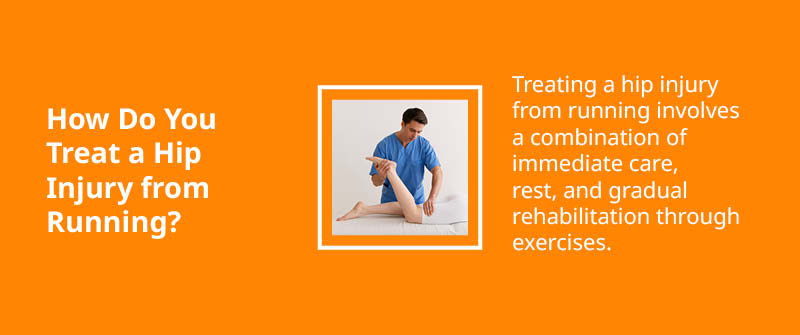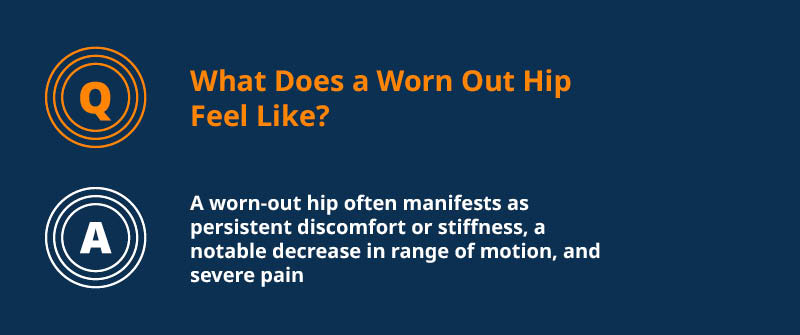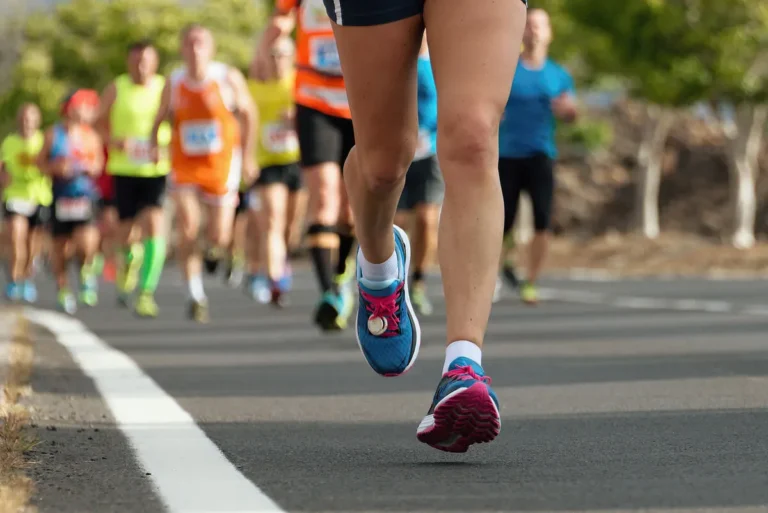When runners are sidelined with hip pain, it can be frustrating to say the least. When you understand the symptoms and causes of the most common injuries, however, you can minimize how long you are sidelined before you’re ready to get back into action. Keep reading for an overview of runner’s hip and other common injuries, as well as how to treat them through proper form and physical therapy for runners.
Schedule your appointment today at Bull City PT’s Durham or Brier Creek offices.
Hip Injury from Running: Understanding Runner’s Hip
Runner’s hip, often referred to as hip bursitis or iliotibial band syndrome, is a common condition among runners that involves inflammation and pain around the hip area. The causes of hip pain in this context are typically due to excessive strain on the hip joint, which can be the result of repetitive motion or poor running form.
Definition and Causes of Runner’s Hip
Runner’s hip is primarily caused by the overuse and stress placed on the hip muscles and tendons during running. The structure of the hip bones can also contribute to the condition, as variations in these bones may lead to joint pain or discomfort during specific movements. Factors such as poor posture, running on uneven surfaces, wearing inappropriate footwear, and increasing running distances too quickly can worsen the condition. The hip joint and surrounding structures work hard to stabilize the body during movement, and when pushed beyond their limits, inflammation and pain can ensue.
Common Symptoms Experienced by Runners
Typically, those with hip pain after running report symptoms like a sharp pain on either side of the hip, a persistent ache, or even pain in the buttocks or down the leg. Stiffness and reduced range of motion may also be present. These symptoms can significantly impact performance and enjoyment of running, underscoring the need for awareness and appropriate preventative measures.
Differences Between Inside and Outside Hip Pain
The specific location of pain can provide clues about its underlying cause. For example, outside hip pain after running often points to iliotibial band syndrome, where the band rubs against the femur. Pain felt more internally may suggest an issue with the hip flexors or even the joint itself, however. Issues with the femoral head can also cause internal hip pain, as its interaction with the hip joint socket can lead to stress fractures or labral tears. Understanding these differences can guide effective treatment strategies and help in preventing further injury.
How Do You Treat a Hip Injury from Running?
Treating a hip injury from running involves a combination of immediate care, rest, and gradual rehabilitation through exercises. Implementing strategies to reduce pain is crucial in the treatment process. It’s important to address the pain early to prevent further damage and ensure a speedy recovery.
Immediate Steps to Take After Experiencing Hip Pain
When you first develop hip pain from running, it’s crucial to stop running immediately to prevent making it worse. You can also apply ice to the affected area to reduce swelling and alleviate pain, and take anti-inflammatory medications, if appropriate, to help ease short-term discomfort.
Importance of Rest and Gradual Return to Running
Rest is essential for healing a hip injury, so it’s important to allow your body sufficient time to recover before returning to your regular running routine. Simply pushing through the pain can lead to more serious injury, prolonged recovery, or even permanent damage. Proper assessment and rehabilitation strategies are crucial for addressing a hip flexor strain, especially to differentiate it from labral pathology. Once pain-free, it’s important to increase your running load gradually, in order to avoid re-aggravating the injury.
Stretching and Strengthening Exercises
Incorporating outside hip pain after running stretches can be beneficial in treating and preventing hip injuries. Specific stretches and exercises are crucial to prevent hip pain, especially for runners. Focus on exercises that enhance flexibility and strengthen the hip muscles, such as hip flexor stretches and glute bridges. Consistent stretching and strengthening can improve stability and endure endurance.
When to Seek Professional Medical Advice
Consult a healthcare professional if your hip pain persists or worsens after initial treatment. A physical therapist can provide a tailored recovery plan, which will often include physical therapy or medical interventions, ensuring a well-rounded approach to recovery.
How Long Does a Hip Injury from Running Take to Heal?
Understanding the healing time for a hip injury from running is essential to set realistic recovery expectations, with the expected duration varying based on the severity of the injury, individual healing capacities, and other factors. For more severe injuries like a stress fracture, recovery time can extend to several months, necessitating adequate rest and medical attention. While minor strains may heal in a few weeks, more severe injuries might require several months for full recuperation.
Factors Affecting Healing Time
There are several factors that influence how quickly your hip pain after running one side might improve. These include the type and severity of the injury, such as muscle strain, as well as your overall health, age, adherence to recovery protocols, and whether you are integrating specific inside hip pain after running therapies such as physical therapy or rest. Committing to a tailored rehabilitation plan and avoiding aggravating activities can expedite healing.
Typical Recovery Timelines for Common Hip Injuries, Including Hip Labral Tear
Many common running-related hip injuries, such as strains or mild tendonitis, may typically heal within four to six weeks with consistent care. More significant issues, like stress fractures or severe tendon injuries, can extend recovery to three to six months. Labral tears, which can result from repetitive activities like running, may also require extended recovery time and potentially surgical intervention if conservative treatments are ineffective. Adhering to medical advice regarding activity modification and rehabilitation is crucial to avoid prolonging recovery.
Tips for Preventing Re-Injury
Preventing re-injury is vital for maintaining your running routine and keeping hip pain at bay. Recognizing muscle strains as a common cause of hip pain in runners is crucial, as these common running injuries often result from excessive training or sudden increases in intensity. Engage in regular strengthening exercises targeting the hip muscles and incorporate flexibility stretches into your routine. Pay attention to your inside hip pain after running signals and give your body adequate rest. Maintaining a balanced training regime that includes cross-training activities can further aid in preventing overuse injuries.
What Does a Worn Out Hip Feel Like?
Feeling like your hip is “worn out” is a common concern, especially for active individuals who push their bodies through rigorous activities like running. A worn-out hip often manifests as persistent discomfort or stiffness, a notable decrease in range of motion, and severe pain that may feel deep and throbbing, predominantly around the groin area or front hip. While normal running might cause temporary ache, a worn-out hip leads to enduring pain that can uncomfortably linger even when off your feet.
Symptoms and Signs of a Worn-Out Hip
One of the primary indicators of a worn-out hip is the persistence of pain, particularly when resting post-activity. The hip joint consists of the femoral head at the top of the thigh bone, which connects to the pelvic socket. This pain can make simple tasks, such as standing from a seated position, incredibly difficult. You may also notice a subtle grinding sensation, coupled with reduced flexibility, causing even mundane activities such as tying your shoes to become difficult.
How It Differs From Typical Running Hip Pain
Running hip pain is primarily acute—meaning it emanates from overuse or improper form—and typically focuses on the outside hip or near the joint. This type of pain is often manageable with rest, stretching, or physical therapy interventions. Conversely, a worn-out hip suggests more significant wear or degeneration within the hip joint, such as a hip labral tear. A hip labral tear is a tear in the cartilage known as the labrum that surrounds the outer rim of the hip joint, emphasizing the structural importance of the labrum in maintaining hip stability and function.
Long-Term Management and Treatment Options
For long-term management, incorporating low-impact activities such as swimming or cycling can ease joint stress while maintaining fitness levels. Consistent strengthening and flexibility exercises tailored to individual needs and appropriate footwear can also mitigate symptoms. When necessary, professional evaluation can determine if you might benefit from physical therapy or surgical interventions. If you have a labral tear, which involves the cartilage surrounding the hip joint, professional evaluation is crucial to assess the need for potential surgical interventions and to develop an effective treatment plan.
If you’re feeling limited by ongoing hip discomfort, let us guide you toward an active, fulfilling lifestyle. Experience the specialized care and personalized treatment at Bull City PT, where our multidisciplinary team is dedicated to helping you achieve pain-free movement. Get started today!









